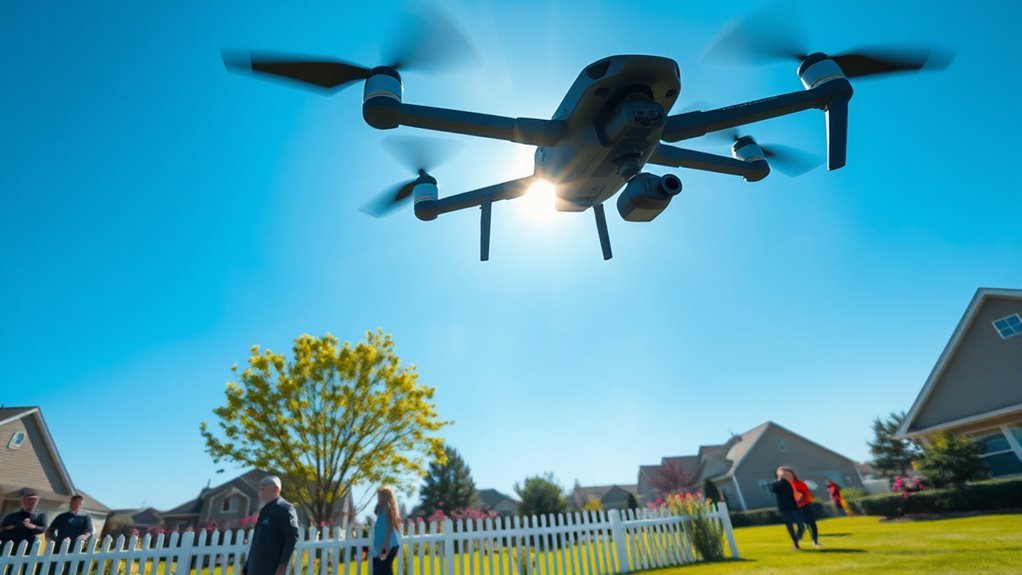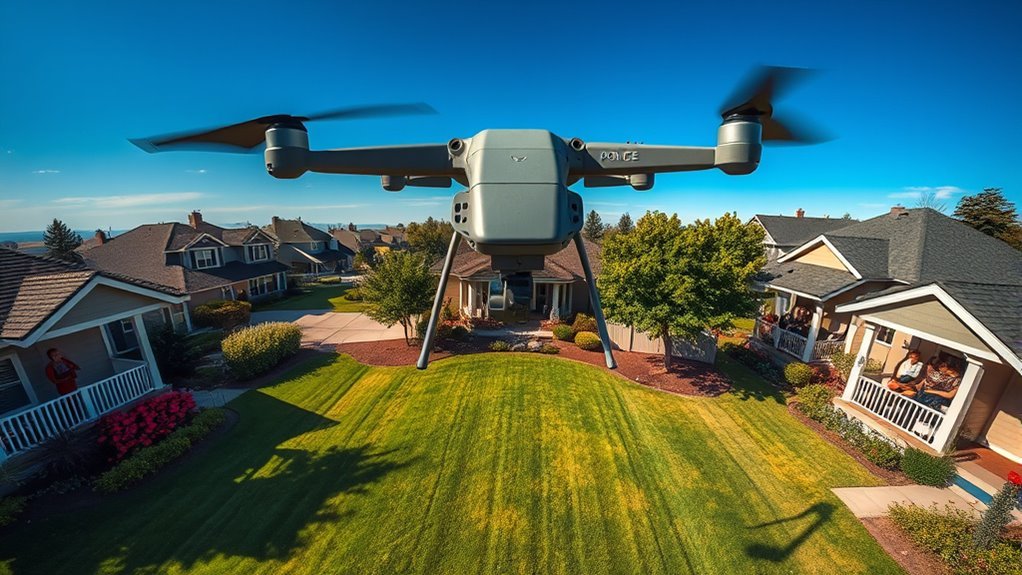Police drones can fly over your property, but their use is subject to legal regulations that balance public safety with your privacy rights. The Fourth Amendment protects against unreasonable searches, which raises questions about aerial surveillance. Courts often consider your expectation of privacy versus law enforcement’s monitoring needs. This complex interaction can vary by jurisdiction. If you’re interested in understanding how these factors play out in real scenarios, you’ll find the details enlightening.
Understanding Drone Technology and Its Uses in Law Enforcement

As law enforcement agencies increasingly adopt drone technology, it’s essential to understand how these unmanned aerial vehicles (UAVs) function and their various applications. Drones offer significant capabilities, including aerial surveillance, real-time data collection, and rapid response in emergency situations. These features enhance law enforcement applications by providing officers with advanced tools for crime scene analysis, search and rescue operations, and traffic monitoring. Additionally, drones can access hard-to-reach areas, offering insights that ground units might miss. Given your desire for freedom, it’s important to recognize that while drones can improve public safety, their deployment must be balanced with respect for individual rights. Understanding drone capabilities helps you appreciate their potential benefits and the necessary discussions around privacy and regulation. Furthermore, the integration of AI-driven sensors can significantly enhance threat detection and monitoring efficiency in law enforcement operations. For instance, the advanced LiDAR and thermal imaging used in drones like Draganfly can provide critical insights during emergency response situations.
Legal Framework Governing Aerial Surveillance

While the use of drones in law enforcement presents clear benefits, it also raises important legal considerations regarding aerial surveillance. You need to understand that various legal regulations govern how and when law enforcement can deploy drones. These regulations often focus on balancing public safety and individual privacy rights. Agencies must navigate federal, state, and local laws, which can vary greatly. For instance, some jurisdictions may require warrants for drone usage, while others may not. It’s crucial to stay informed about your local laws, as they directly impact how drones can operate over your property. Ultimately, the legal framework surrounding aerial surveillance is complex and continually evolving, reflecting a society’s ongoing dialogue about freedom and privacy. Additionally, local regulations can dictate specific operational areas and restrictions for drone flights.
The Fourth Amendment and Privacy Rights

When law enforcement agencies deploy drones for surveillance, the Fourth Amendment becomes a crucial consideration in the conversation about privacy rights. This amendment protects you against unreasonable searches and seizures, raising important questions about your privacy expectations. Aerial intrusion by drones can challenge these expectations, especially when drones operate over private property. Courts often grapple with balancing public safety and individual rights, determining whether surveillance constitutes an invasion of privacy. If you have a reasonable expectation of privacy in your surroundings, such aerial monitoring could be deemed unconstitutional. As technology advances, it’s essential to remain vigilant about how these rights are interpreted and upheld, ensuring that your freedom from unwarranted surveillance is preserved.
Case Studies: Court Decisions on Drone Usage
In examining case studies on drone usage, you’ll find that legal precedents play an essential role in shaping regulations for law enforcement. Courts have often weighed privacy rights against the need for public safety, leading to varied outcomes. Understanding these decisions can help clarify the boundaries of drone surveillance in relation to personal property.
Legal Precedents Established
As courts grapple with the implications of drone technology, several key legal precedents have emerged that shape the boundaries of police usage over private property. In cases like *Florida v. Riley*, the Supreme Court determined that aerial observations made from a lawful altitude don’t violate privacy rights, influencing drone regulations markedly. Conversely, the *United States v. Causby* case established that property owners have rights to the airspace above their land, emphasizing the importance of aerial privacy. These rulings illustrate the delicate balance between law enforcement’s needs and individual freedoms, prompting ongoing debates about the legality of drone surveillance. As drone technology evolves, so too will the legal landscape governing its use, necessitating careful scrutiny of future court decisions.
Privacy Rights Considerations
While the legal landscape surrounding drone usage continues to evolve, several court cases have highlighted significant privacy rights factors that impact how law enforcement deploys this technology. You should be aware that courts have often examined the balance between effective policing and individual privacy. For instance, in *Florida v. Riley*, the Supreme Court ruled that police could use drones for aerial surveillance without a warrant, emphasizing the open nature of the airspace. However, this decision raised concerns about potential privacy implications, leading to calls for clearer drone regulations. Ultimately, as drone technology becomes more prevalent, it’s essential to reflect on how these legal precedents shape your rights and the methods police use to monitor and investigate.
Law Enforcement Regulations
Although the legal framework governing police drone usage is still developing, several pivotal court decisions have established guidelines that shape law enforcement practices. These cases often hinge on the Fourth Amendment, evaluating whether drone surveillance constitutes an unreasonable search. For instance, in *Florida v. Riley*, the Supreme Court ruled that police could use drones to observe private property without a warrant, setting a precedent for drone policies. Regulatory oversight is crucial, as it guarantees that law enforcement adheres to constitutional protections while deploying drones. As you consider these developments, it is vital to recognize that the balance between effective policing and individual freedoms remains a contentious issue, prompting ongoing debates about the implications of drone surveillance on privacy rights.
Public Perception and Concerns Regarding Police Drones
As you consider the use of police drones, privacy invasion fears often come to the forefront of public discourse. Many people express concerns about surveillance overreach and its implications for community safety. Balancing these perspectives is essential to understanding the broader impact of drone technology in policing.
Privacy Invasion Fears
Given the increasing deployment of police drones, many individuals express concerns about potential invasions of privacy. These privacy concerns stem from the nature of aerial surveillance, which can unintentionally capture personal moments without consent. Here are three primary worries:
- Constant Monitoring: Drones can hover and observe activities in your backyard or home, leading to feelings of being watched.
- Data Misuse: There’s anxiety about how collected footage may be stored or used, potentially violating individual rights.
- Erosion of Trust: The presence of drones may foster distrust between communities and law enforcement, undermining public cooperation.
Ultimately, addressing these fears is essential for maintaining a balance between safety and personal freedom. Your right to privacy deserves respect, even in the context of policing.
Surveillance Overreach Concerns
How far is too far when it comes to police surveillance? As drones become commonplace in law enforcement, many people express concerns about surveillance overreach. This raises critical questions about surveillance ethics and the potential erosion of public trust. You might wonder if the intrusion of drones into your personal space signifies a troubling trend towards unchecked authority. The balance between safety and privacy is delicate, and it’s essential to reflect on how these technologies impact community perceptions. While some argue that drones enhance security, the fear of constant monitoring can lead to a chilling effect on free expression. Ultimately, the challenge lies in ensuring that police practices respect individual rights while fostering transparency to maintain public trust in law enforcement.
Community Safety Perspectives
While many people recognize the potential benefits of police drones for enhancing community safety, concerns about their impact on privacy and civil liberties remain prevalent. Your perspective on police drones can shape community engagement and safety awareness. Here are three key concerns:
- Privacy Erosion: Drones may invade personal space, leading to unease about constant surveillance.
- Civil Liberties: The use of drones can raise questions about the balance between safety and individual rights, potentially resulting in overreach.
- Public Trust: Transparency in drone operations is essential; without it, community trust in law enforcement may diminish.
Understanding these issues can help you advocate for responsible use of technology while promoting safety in your community.
What Rights Do Property Owners Have?
Property owners possess certain rights that can considerably influence the use of drones by law enforcement. You have property rights that protect your domain from unwanted intrusions, including aerial trespass by drones. Generally, if a drone flies over your property at a low altitude, it may be considered an infringement on your rights. Courts often weigh your expectation of privacy against law enforcement’s need for aerial surveillance. While police may argue their right to monitor for public safety, your right to maintain privacy remains significant. Understanding these nuances is essential in maneuvering potential conflicts with drone usage. Ultimately, the balance between public safety and individual rights is a complex issue that continues to evolve in the domain of property law.
Future Implications of Drone Technology in Law Enforcement
As drone technology continues to advance, its integration into law enforcement practices is likely to reshape policing strategies and community interactions. You might consider the following implications:
- Enhanced Surveillance: Drone advancements could enable real-time monitoring of public spaces, raising concerns about privacy and civil liberties. Additionally, the use of advanced autonomous navigation in drones can enhance surveillance capabilities by allowing for seamless path planning and obstacle avoidance.
- Rapid Response: Drones can provide immediate assistance in emergencies, but this might also lead to over-reliance on technology in crisis situations.
- Community Relations: The use of drones could foster distrust if not accompanied by transparent policies, emphasizing the importance of technology ethics in their deployment. Furthermore, the potential US ban on DJI could lead to a shift in available drone technologies used by law enforcement agencies, impacting their operational capabilities.
Balancing these benefits and potential drawbacks will be essential in ensuring that law enforcement respects individual freedoms while effectively utilizing drone technology. Your awareness and engagement in this dialogue are important for shaping ethical practices.
Frequently Asked Questions
Can Police Drones Record Video While Flying Over My Property?
Yes, police drones can record video while flying over your property, but there’re privacy concerns. Regulations vary by state, so it’s essential to understand local laws governing drone surveillance to protect your rights.
How High Can Police Drones Fly Without a Warrant?
When considering drone altitude regulations, you should know that police drones can typically fly up to 400 feet without a warrant. However, local laws may impose stricter restrictions regarding warrant requirements for surveillance activities.
Are There Restrictions on Drone Flight Times Over Residential Areas?
Yes, there’re restrictions on drone flight times over residential areas. Drone flight regulations often aim to balance law enforcement needs with residential privacy, ensuring minimal disturbance during early mornings and late evenings for homeowners.
Can I Request Footage Captured by Police Drones?
Imagine a watchful eye in the sky, capturing moments. You can request drone footage, but privacy concerns often cloud access. Your rights to transparency must balance against the need for security—a delicate dance of freedom and oversight.
What Happens if a Police Drone Crashes on My Property?
If a police drone crashes on your property, liability may depend on circumstances. You could be entitled to compensation for property damage, but proving negligence or responsibility can be complex and may require legal assistance.

